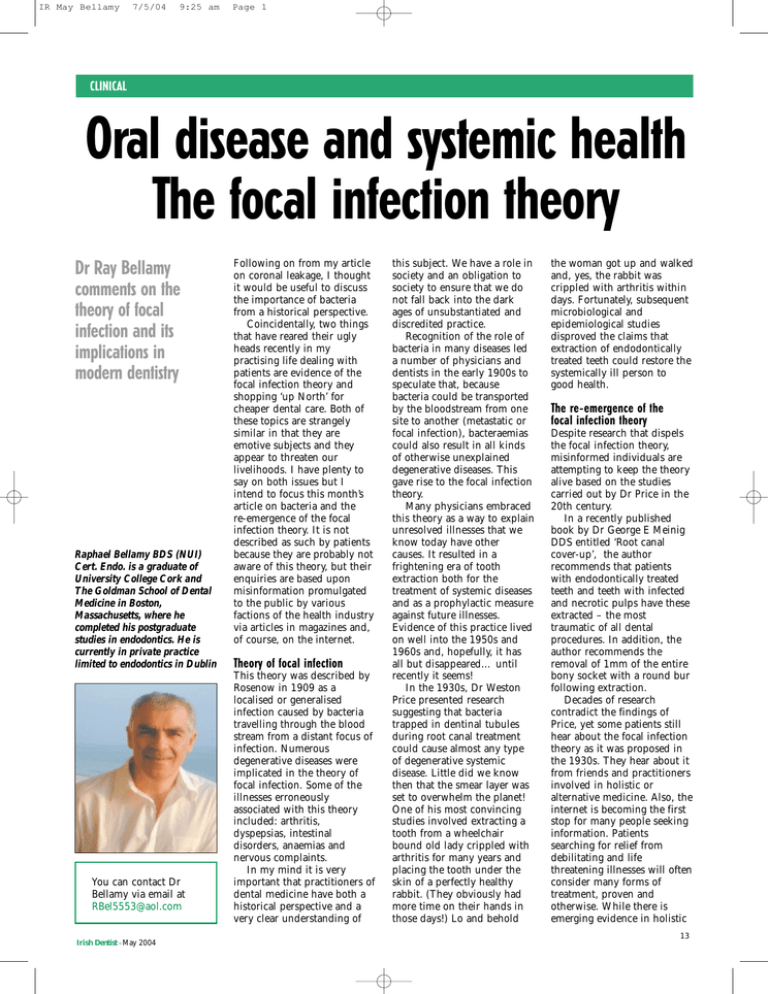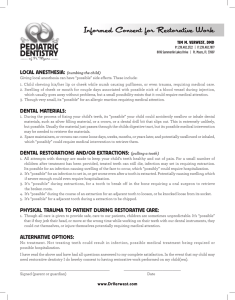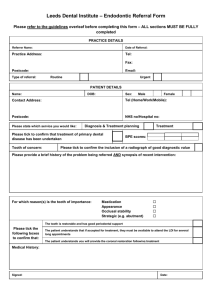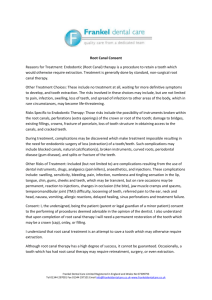Focal Infection Theory & Dentistry: Modern Implications
advertisement

IR May Bellamy 7/5/04 9:25 am Page 1 CLINICAL Oral disease and systemic health The focal infection theory Dr Ray Bellamy comments on the theory of focal infection and its implications in modern dentistry Raphael Bellamy BDS (NUI) Cert. Endo. is a graduate of University College Cork and The Goldman School of Dental Medicine in Boston, Massachusetts, where he completed his postgraduate studies in endodontics. He is currently in private practice limited to endodontics in Dublin You can contact Dr Bellamy via email at RBel5553@aol.com Irish Dentist May 2004 Following on from my article on coronal leakage, I thought it would be useful to discuss the importance of bacteria from a historical perspective. Coincidentally, two things that have reared their ugly heads recently in my practising life dealing with patients are evidence of the focal infection theory and shopping ‘up North’ for cheaper dental care. Both of these topics are strangely similar in that they are emotive subjects and they appear to threaten our livelihoods. I have plenty to say on both issues but I intend to focus this month’s article on bacteria and the re-emergence of the focal infection theory. It is not described as such by patients because they are probably not aware of this theory, but their enquiries are based upon misinformation promulgated to the public by various factions of the health industry via articles in magazines and, of course, on the internet. Theory of focal infection This theory was described by Rosenow in 1909 as a localised or generalised infection caused by bacteria travelling through the blood stream from a distant focus of infection. Numerous degenerative diseases were implicated in the theory of focal infection. Some of the illnesses erroneously associated with this theory included: arthritis, dyspepsias, intestinal disorders, anaemias and nervous complaints. In my mind it is very important that practitioners of dental medicine have both a historical perspective and a very clear understanding of this subject. We have a role in society and an obligation to society to ensure that we do not fall back into the dark ages of unsubstantiated and discredited practice. Recognition of the role of bacteria in many diseases led a number of physicians and dentists in the early 1900s to speculate that, because bacteria could be transported by the bloodstream from one site to another (metastatic or focal infection), bacteraemias could also result in all kinds of otherwise unexplained degenerative diseases. This gave rise to the focal infection theory. Many physicians embraced this theory as a way to explain unresolved illnesses that we know today have other causes. It resulted in a frightening era of tooth extraction both for the treatment of systemic diseases and as a prophylactic measure against future illnesses. Evidence of this practice lived on well into the 1950s and 1960s and, hopefully, it has all but disappeared… until recently it seems! In the 1930s, Dr Weston Price presented research suggesting that bacteria trapped in dentinal tubules during root canal treatment could cause almost any type of degenerative systemic disease. Little did we know then that the smear layer was set to overwhelm the planet! One of his most convincing studies involved extracting a tooth from a wheelchair bound old lady crippled with arthritis for many years and placing the tooth under the skin of a perfectly healthy rabbit. (They obviously had more time on their hands in those days!) Lo and behold the woman got up and walked and, yes, the rabbit was crippled with arthritis within days. Fortunately, subsequent microbiological and epidemiological studies disproved the claims that extraction of endodontically treated teeth could restore the systemically ill person to good health. The re-emergence of the focal infection theory Despite research that dispels the focal infection theory, misinformed individuals are attempting to keep the theory alive based on the studies carried out by Dr Price in the 20th century. In a recently published book by Dr George E Meinig DDS entitled ‘Root canal cover-up’, the author recommends that patients with endodontically treated teeth and teeth with infected and necrotic pulps have these extracted – the most traumatic of all dental procedures. In addition, the author recommends the removal of 1mm of the entire bony socket with a round bur following extraction. Decades of research contradict the findings of Price, yet some patients still hear about the focal infection theory as it was proposed in the 1930s. They hear about it from friends and practitioners involved in holistic or alternative medicine. Also, the internet is becoming the first stop for many people seeking information. Patients searching for relief from debilitating and life threatening illnesses will often consider many forms of treatment, proven and otherwise. While there is emerging evidence in holistic 13 IR May Bellamy 7/5/04 9:25 am Page 2 CLINICAL medicine linking the mind, the body and the spirit, there is no evidence that bacteria present in the dentinal tubules of teeth cause systemic disease. Our job as dentists is to assure patients concerned about the safety of endodontic therapy that we are also concerned about their overall well-being and that endodontic treatment is a safe, successful path to continued good health. Oral bacteria and the importance of endodontic treatment Oral bacteria enter the bloodstream in many ways, including chewing, tooth brushing, flossing and dental procedures. Research shows that the healthy immune system takes care of such transient bacteraemias in a matter of minutes. The incidence and magnitude of bacteraemias of oral origin are directly proportional to the degree of oral inflammation and infection. This can be directly related also to the magnitude of trauma inflicted by dental procedures. Whereas dental extraction would cause a great deal of trauma and a high incidence of bacteraemia, endodontic treatment confined to the root canal system produces a much lower incidence of bacteraemia. Consequently, neither the American Heart Association nor the American Association of Endodontics recommend antibiotic prophylaxis for endodontic treatment in the ‘at-risk’ individual. This ought to be noted and will be the subject of a separate article at a later date. Choosing endodontic treatment over extraction whenever possible is the safer, less invasive option and less expensive in the long run. To restore chewing function and to prevent adjacent teeth from shifting, an extracted tooth must be replaced with an implant or bridge. This requires implant surgery or dental procedures on adjacent healthy teeth, which may also require root canal treatment later. These procedures can be far more costly and time consuming than endodontics and the restoration of the natural tooth. As effective as modern tooth replacements may be, nothing is as good as a natural tooth. Endodontic treatment has been proved time and again to be a safe and effective way to preserve a patient’s natural dentition for many years. More recently, with the advent of more reliable implants of shorter placement to loading times, there appears to be a growing tendency to move dangerously quickly to extraction of the natural tooth. This is a big mistake. Although implants are a valuable adjunct in restorative dentistry and at last provide a real possibility for the judicious replacement of the missing tooth, this fact should never sway our judgement of what is best for the patient. In my opinion, the general standard of endodontic care in these islands has yet to reach an acceptable level to predictably safeguard the future of the restored tooth. I consider it my vocation and duty to enlighten all those who are in doubt. There are many. We know that it works. We know that endodontics is set firmly on sound principles discussed time and again within these pages. Just because it is technically difficult, time consuming and costly, it is no reason to forgo this form of treatment. Responding to patients’ concerns What will you do when a patient asks you if endodontic treatment is safe? You will need to discuss your patient’s concerns and, while acknowledging their concern in their personal health, reinforce the idea that their general health is of importance to you also. Optimum health for your patient is what health care is all about. Refrain from maligning any health care practitioner the patient quotes. You need not worry because the science is on your side. Explain that studies have shown no correlation between the presence of endodontically treated teeth and the presence of systemic illness, and what the patient has heard may be based on outdated theories from the early 1900s. Point out that extracting the tooth and enlarging the socket with the bur is an extremely radical treatment. Discuss the fact that endodontic treatment is recommended over extraction for medically compromised patients because it is less traumatic. Stress that endodontic treatment is considered safer than extraction for people who are predisposed to The right patients and the right treatment The 7 tactics to create a low cost marketing engine and the 4 keys to ethically sell more treatment qua lifie s for 6C PE poi One-day lecture Friday 14 May 2004 nts Chris Barrow bacterial endocarditis and joint infections, because it introduces fewer microorganisms into the bloodstream. Emphasise that the patient would need extensive restorative procedures after extractions in order to continue with the foods he or she likes to eat. Further restorative procedures can cause pulp damage and can give rise to more expense. Explain clearly that once a tooth has been root treated, the tooth must be restored permanently within a short period of time. As stated in my article on coronal leakage, a root canal treatment without a permanent restoration is not complete and could cause further damage and possible loss of the tooth. Explain that some bacteria may remain within the dentinal tubules (tooth) but there is no evidence that these bacteria release toxins resulting in chronic systemic disease or travel to other parts of the body. Nearly a century of sound research has proven the safety and efficacy of endodontic treatment for the elimination of pain and infection, and the preservation Z of natural teeth. References AAE guidelines on antibiotic prophylaxis (www.aae.org) Meinig GD (2000) Root canal cover-up. AAE Endodontics Colleagues for Excellence Spring/Summer The Prevention of Bacterial Endocarditis (1997) American Heart Association Independent Seminars FMC Ltd, 1 Hertford House, Farm Close, Shenley, Hertfordshire, WD7 9AB United Kingdom. Tel: +44 1923 851 777 Fax: +44 1923 851 778 email: seminars@fmc.co.uk www.dentistryseminars.com th The Alexander Hotel in DUBLIN 14 Irish Dentist May 2004






